82 years ago today, in combat with the Japanese during the Solomon Islands Campaign in World War II, Patrol torpedo boat PT-109 was rammed by the Japanese Destroyer Amagiri. It’s commanding officer, a certain Lieutenant John F. Kennedy, undertook almost single-handedly to rescued his crew of 12 men, saving all but two in the process, while being seriously injured. The event won Kennedy multiple decorations for bravery, and made him a bona fide war hero. READ how the event unfolded… (1943)
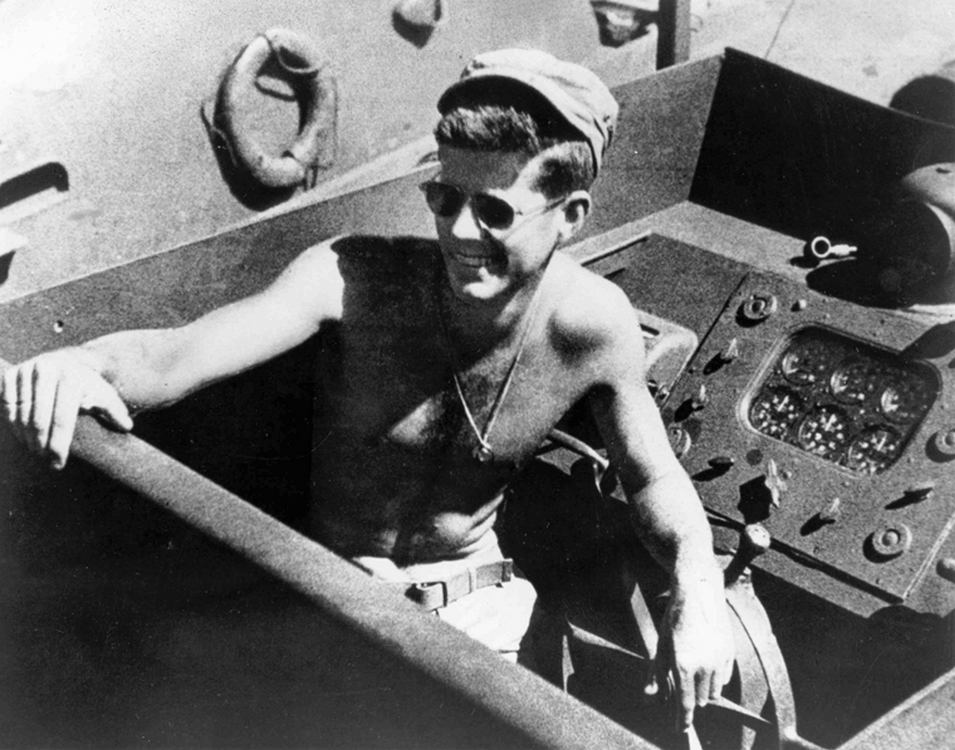
Inquirers and historians generally do not find the then-future president at fault for the collision. It happened that Kennedy had received orders, along with other patrol boats, to continue patrol operations after dark. Kennedy was idling PT-109 on a single engine to avoid detection by enemy aircraft.
Eventually he realized they were in the path of the destroyer Amagiri, which was returning northward after dropping off supplies and soldiers on Kolombangara. Patrol torpedo boats were not very maneuverable, and with only one engine, there was little time to escape the fast Japanese warship, which Kennedy had not been warned about on the radio.
Kennedy ordered his men to fire a torpedo, along with a 37mm antitank gun at the ship, but they had almost no time to do so. Amagiri struck PT-109 on the starboard side and sheared off a large piece of the vessel. The fuel then exploded causing a fireball 100 feet high. Seamen Andrew Jackson Kirksey and Harold William Marney were killed instantly, two other members of the crew were badly injured and burned when they were thrown into the flaming sea surrounding the boat.
Kennedy was able to rescue MM1 Patrick McMahon, the crew member with the most severe wounds, which included burns that covered 70 percent of his body, and brought him to the floating bow. Kennedy also rescued Starkey and Harris, bringing them both to the bow. The ship, though, was sinking. The survivors regrouped and used a wooden plank to support their torsos while they swam to the deserted Plum Pudding Island. Kennedy, who had been on the Harvard swim team, used a life jacket strap clenched between his teeth to tow McMahon behind him for 5 hours. Once on the island, Kennedy eventually undertook another 2 hour swim to hail passing allied vessels until they were found and rescued.
MORE Good News on this Day:
- African-Americans in the United States voted for the first time in a state election—in the southern state in Tennessee (1867)
- 249 years ago today, the US Continental Congress began formally signing the Declaration of Independence, sealing their break with the British Crown by becoming rebel colonies (1776)
- New Orleans re-named their airport the Louis Armstrong Airport, in honor of the trumpet player, singer, and bandleader, one of the city’s favorite sons (2001)
- Liberian President Charles Taylor agreed to cede power (2003)
5 years ago today, the women of Saudi Arabia were given the right to travel abroad without a male guardian, a major advance in rights for women in the country. This meant that women over the age of 21 could apply for passports of their own volition, while the Kingdom simultaneously passed laws permitting females to register births, marriages, or divorce.

According to the BBC, Saudi’s male guardianship system gives husbands, fathers, and other male relatives the authority to make critical decisions about women.
It meant women in the Kingdom were required to seek those relatives’ permission to obtain or renew a passport and exit the country. The first woman to become an envoy for the kingdom, Saudi ambassador to the US Reema bint Bandar Al Saud, hailed the changes. (2019)
13 years ago today, Michael Phelps won an unprecedented third consecutive Olympic gold medal in the 200-meter individual medley, his 16th gold medal in total, becoming the first man ever to win the event in three Olympics in a row. This win also marked Phelps’s fifth Olympic title in the individual medley, breaking the record of four shared by Hungarian Tamás Darnyi and Ukrainian Yana Klochkova.

While the 2012 games in London started badly for Phelps, raising considerations that maybe he was past his pomp, he turned the season around by winning gold in the 4×200-meter freestyle relay, and the gold in the 100-meter butterfly.
This meant he repeated his heroics of the 200-meter individual medley, becoming the first man ever to win the 100-meter butterfly in three consecutive games. Phelps’s final event was the 4×100-meter medley relay in which he went on to win his 18th career gold medal, making him the most decorated swimmer, male or female, and Olympian in general, of all time. (2012)
33 years ago today, at the 1992 Summer Olympics in Barcelona, Belarusian artistic gymnast Vitaly Scherbo, representing the Commonwealth of Independent States, became the first gymnast to win 6 gold medals in a single games, collecting for the pommel horse, rings, vault, parallel, team, and all-around, making him also the most prolific athlete that year.

It would have been easy to imagine following the breakup of the Soviet Union that countries lacking in funding and preparation for the games would struggle. Sometimes called the “Unified Team,” it consisted of Armenia, Georgia, Azerbaijan, Belarus, the Central Asian republics, Moldova and Ukraine.
Beyond his ballistic ’92 Olympics, Scherbo won 9 gold medals across three editions of the World Championships in gymnastics. WATCH his flawless performances in Barcelona… (1992)
34 years ago today, the Viking replica longship ‘Gaia‘ reached the first Norse settlement in North America, almost 1,000 years after Leif Eriksson’s landing, after crossing from Norway.
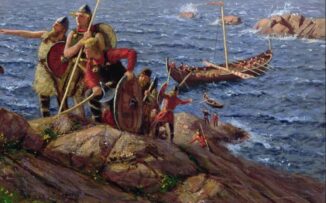
Eriksson was a Norse explorer from Iceland, credited with being the first European to set foot on the continent, having landed in Newfoundland. Gaia was built in Bjorkedalen, Norway, to be a replica of the original 890 AD Gokstad Ship which successfully made the voyage, but was only unearthed 140 years ago.

Gaia later made the journey to New York via Greenland and Canada, and she sailed on to Rio de Janeiro to mark the first UN World Conference on the Environment.
In 1993 she returned to Norway and was given as a gift to the town of Sandefjord (where the original ship was excavated). Since then, Gaia has been in frequent use, visiting ports in England, Scotland, Germany, France, and The Netherlands. WATCH the amazing historical footage of the boat launch… (1991)
155 years ago today, the world’s first underground tube railway, the Tower Subway, opened in London, a wonder of the Victorian age.
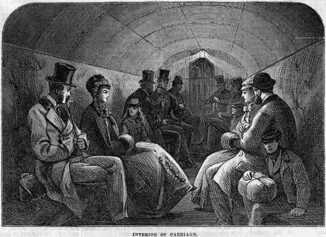
The quarter-mile-long tunnel under the Thames River was excavated in less than a year, thanks to the project’s civil engineer James Henry Greathead who invented a cylindrical, iron tunneling shield technology that still forms the basis of modern machines used to burrow tunnels today.

Though closed to the public in 1898, the passageway with its small brick entrance still stands near the Tower of London.
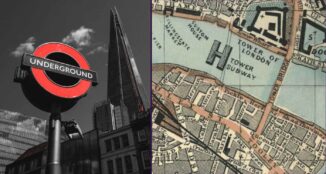
In just 70 seconds, 12 passengers at a time could be moved from the north to the south bank while 22 feet beneath the riverbed in a rail car pulled by a steel cable powered by stationary steam engines on either side. (1870)
On this day in 1869, Japan abolished its Samurai class system.
 Under the massive reforms of the Meiji Restoration (Meiji means “enlightened rule”), all feudal class privileges were abolished, ending the traditional Confucian hierarchical order that had persisted since 600 AD. Under the caste system, society’s classes were not arranged by wealth but by usefulness. Peasants came second because they produced the most important commodity, food; third were Artisans because they produced nonessential goods; and Merchants were at the bottom of the social order because they generated wealth without producing any goods.
Under the massive reforms of the Meiji Restoration (Meiji means “enlightened rule”), all feudal class privileges were abolished, ending the traditional Confucian hierarchical order that had persisted since 600 AD. Under the caste system, society’s classes were not arranged by wealth but by usefulness. Peasants came second because they produced the most important commodity, food; third were Artisans because they produced nonessential goods; and Merchants were at the bottom of the social order because they generated wealth without producing any goods.
One of the primary differences between the samurai (pictured above) and peasant classes was the right to carry swords; this ancient privilege was suddenly extended to every male in the nation.
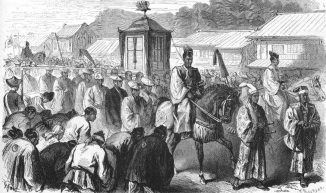
After the Meiji reforms, which restored direct political power to the emperor for the first time in over a millennium—by seizing control of hundreds of disparate territories and establishing a constitution—Japan underwent a period of sweeping political, military, and social reform. The island nation, with its new capital Tokyo, rapidly industrialized its production methods and became the first Asian state to westernize itself, adopting policies such as creating a national system of public schools.
And, 21 years ago today, Eric Clapton bought a 50% share in Cordings to save the historic British gentleman’s outfitters, based in London since 1839, from closure.

The guitarist said he had been fond of the West End shop since a window display of a tweed suit caught his eye when he was 16, and he became a regular shopper there. Cordings was the originator of the Covert coat and the Tattersall shirt and made riding boots for the Queen Mother. (2004)
Also, on this day in 1973, American Graffiti, the first successful film directed and co-written by George Lucas, premiered. The coming-of-age comedy starring Richard Dreyfuss and Ron Howard also featured Harrison Ford, a young actor who had become a professional carpenter because acting roles weren’t paying the bills. (The gig profoundly changed his career as he was cast in Lucas’s next film, Star Wars.) An Oscar Best Picture nominee, American Graffiti was produced with a tiny budget of $777,000 and became one of the most profitable films of all time.
Set during a single night in 1962, the film glimpses the car-cruising, rock-and-roll culture popular among teens of the post–World War II baby boom generation—and it was the inspiration for Happy Days, the hit TV comedy series also starring Ron Howard. WATCH a clip with the young Harrison…
SHARE the Milestones, Memories, and Music…
